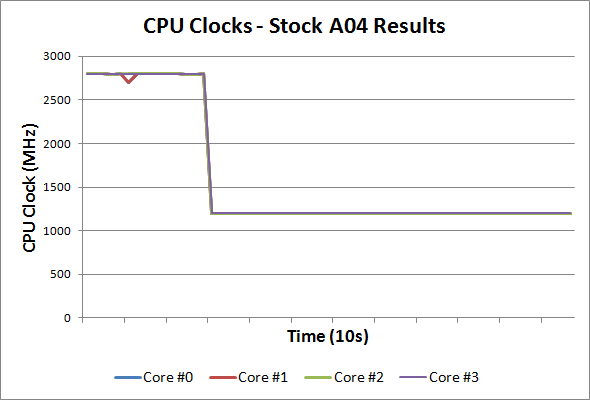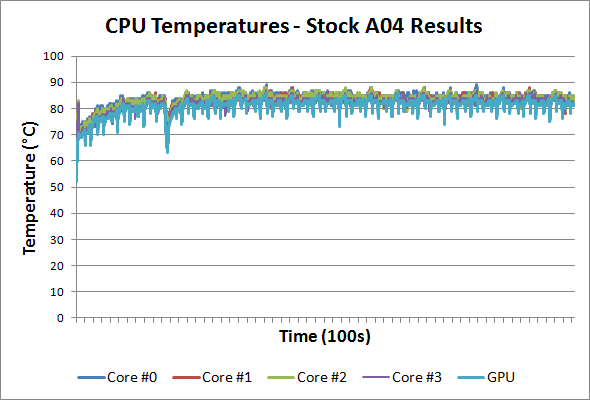Dell XPS 15 L521X: A Detailed First Look
by Jarred Walton on July 25, 2012 1:10 AM ESTDell XPS 15 Thermal and Throttling Investigations
Considering the CPU throttling that’s occurring with the current BIOS, we have several sets of data to examine. We logged clock speeds and temperatures on the CPU and GPU using HWiNFO64, and we’ll analyze the results here. Let’s start first with the system running “stock” with the A04 BIOS. Again, the current results likely do not represent exactly what we’ll see from future BIOS revisions, but I expect temperatures will be somewhere between the stock and ThrottleStop figures we’ll discuss in a moment. For the stress testing that we’re doing here, we loaded up Cinebench 11.5 rendering with three threads (looped), and we ran 3DMark06 at 1080p on the four gaming tests in a loop. There are slight gaps that occur each time one test ends and the next begins, so a short-term drop in clock speeds isn’t particularly noteworthy; it’s only when we see sustained lower clock speeds that we can clearly state that the system is throttling.

Starting with the clock speeds, it’s immediately obvious how far the CPU is throttling and how significant the problem is. With our stress test workload we’re able to hit the thermal limits (around 80C on the CPU) in just 30 seconds, at which point the CPU drops to 1.2GHz from 2.8GHz. While our graph only shows the first couple of minutes, the 1.2GHz clock remained in effect for over five hours of stress testing, with nary an upward spike until we halted the tests. Most of the time, we were able to run this workload without problems, but we did experience at least one crash. There’s also the question of what would happen under more extreme environmental conditions, as our testing was done in a 70-73F AC cooled environment. Here’s a look at the temperatures for the CPU cores and GPU at stock:

With our particular workload, we reach a maximum CPU temperature of 88C after 20 or so minutes, at which point the cyclical nature of our workload causes the CPU/GPU to fluctuate between 79C and 88C every six or seven minutes (the length of time for a complete 3DMark06 loop). The GPU reaches a maximum temperature of 85/86C after 40 minutes, and again temperatures fluctuate depending on the workload between 76C and 85C over the course of six or seven minutes. A more difficult workload (e.g. Furmark with OCCT) might present problems, but we’re looking at a more realistic scenario and at least the thermal throttling keeps the laptop from crashing.
Running stock is well and good for many, but can we push performance any higher by increasing the CPU clocks? That’s what we attempted to do, and we turned to ThrottleStop for this purpose. Having successfully run all of our gaming suite at 2.3GHz using ThrottleStop, that’s where I started the stress testing. I was a little surprised when the laptop shut down after just 7.5 minutes. Ouch! The CPU cores top out at 100C and the GPU hits 93C, with the laptop sustaining those temperatures for about 30 seconds before crashing (powering off with no warning). With that result in hand (and confirmed with a couple of retests), I stepped the CPU clock back to 2.1GHz. With 200MHz knocked off the CPU clocks, the stress test ran successfully for 20 minutes before once again crashing, and this time the CPU cores maxed out at 99C with the GPU again reaching 93C. The laptop managed to run for five minutes after the first instance of those temperatures, so we’re at least heading in the right direction.
Next up I tried 2.0GHz, thinking I was getting close to “stability”, and the XPS 15 ran for just over an hour before it crashed once again. Maximum CPU temperatures dropped to 98C and the GPU topped out at 92C, but we’re not quite there yet. Interestingly, 1.9GHz on the CPU didn’t do any better, with crashes occurring after 45 to 60 minutes three times before we gave up, and similar max temperatures. At 1.8GHz, we finally reached relative stability, with the XPS 15 handling our looped workload for over four hours. The maximum CPU temperature at 1.8GHz was 95C, and the first time it reached that temperature was just over an hour into the stress test, with the core temperature cycling between 89C and 94/95C every six or so minutes. The GPU maximum temperature was 89C, cycling between 84C and 89C. We put together charts of the CPU/GPU temperatures for our four test runs and you can see them in the following gallery.
As for the system itself, surface temperatures are significantly lower than the CPU and GPU core temperatures reported by HWiNFO, and the chassis never felt uncomfortably hot in our experience—the silicone coating on the bottom helps in this regard, though it may also be inhibiting the radiating of heat through the chassis and contributing to the higher temperatures.
Noise levels are relatively loud (I’d guess around 40dB—I don’t have my SPL meter with me right now), but given the throttling issues the fan should really be spinning faster to compensate—and apparently it can’t. Also note that the exhaust is located under the LCD hinge, which is potentially exacerbating the issue. If the airflow weren’t inhibited by the LCD/hinge, it’s possible the temperatures would drop 5C or more, which might be enough to avoid most of the throttling problems. At idle, noise isn’t a problem at all, with the XPS 15 typically coming in at or below the noise floor of our equipment (30dB). I’d personally rather have a laptop that gets louder but doesn’t overheat, throttle, or even worse crash than a laptop that runs quietly but experiences all of those problems. Of course, in an ideal world you could get both reasonably quiet as well as high performance, but doing so with a thin laptop chassis isn’t in the cards right now. We’ve seen the same issues with throttling (or at least lower clocks) on most of the Ultrabooks we’ve tested as well.















109 Comments
View All Comments
doubledeej - Monday, August 13, 2012 - link
I've bought Dells almost exclusively for 15 years and for the first time they don't offer a machine that meets my needs.I'm a developer, so I type an awful lot. And Dell, along with most other laptop manufacturers, seems to think that nobody actually does any editing on their computers any longer. The omission of dedicated Home, End, Page Up and Page Down keys kills productivity. Yes, I know there is a Fn+ keyboard combo to get to these... but it really hurts the brain when you have to start thinking about holding Control, Shift, and Fn before pressing the left arrow to highlight a document from the current location to the beginning... four keys for any operation is too many.
It saddens me that computer vendors don't think of their power users when designing machines. Who else are going to be their biggest cheerleaders?
alfling - Thursday, August 23, 2012 - link
still no review of Dell Inspiron 15R SE?alfling - Friday, August 24, 2012 - link
Dear Jarred Walton, can you please retest gaming with A06 BIOS?ogrfnkl - Saturday, August 25, 2012 - link
Well, the A06 BIOS update is out as of 8/8/2012, and according to the description on the Dell website, it does address some thermal issues. Specifically, it says: "Set the temps control Tc at 80 degree C for GPS on Sbios. Based on EC X43 version and cut in thermal table V08." Whatever the heck that's supposed to mean! :<It would be great to know whether or not, and to what extent, this update fixes the thermal and throttling issues described in the review. I hope Jarred can re-run the gaming tests and post the new results soon...
Thanks!
ogrfnkl - Saturday, August 25, 2012 - link
Sorry, sorry, I hadn't checked the previous messages -- the new testing has already been done. Thanks, Jarred!tipoo - Sunday, August 26, 2012 - link
http://forum.notebookreview.com/dell-xps-studio-xp...ogrfnkl - Sunday, August 26, 2012 - link
First of all, the thread you've pointed to is from BEFORE the 8/8/2012 A06 update, which is the fix "Dell-Bill_B" is talking about. Second, here is a post by "Dell-Bill_B" from a little further on in the thread (http://forum.notebookreview.com/dell-xps-studio-xp... which I think pretty much gives us the final answer on this whole thermal/throttling topic:"If you require a system that will run the CPU and GPU at 100% load concurrently for more than a few seconds, you bought the wrong system."
Doesn't get any clearer than that, does it? This pretty much nails it for me; I'm starting to look elsewhere for my next system... My question is, why would anyone NOT expect their computer to run at its top speed for a lot more than a few seconds? If it can't, that top speed is completely useless, isn't it? I'd much rather go for an L502x, whose top speed is a few % slower than the L521X's, but it actually CAN and does sustain it indefinitely. Not to mention the absolutely, mindblowingly gorgeous screen on that system.
stcloude - Sunday, October 14, 2012 - link
Dell is on revision A11 of the BIOS. Has this revision resolved the throttling issue at all? I am really disappointed that it has the throttling and wifi issues. I need a new laptop, and wanted something with the build quality of the MacBook Pro, and really thought this was it. I am so tempted to go with Mac, but unfortunately my job requires that I have a PC.Tobi KKKK - Thursday, November 22, 2012 - link
I am also interested in the throttling behaviour under load.Meanwhile, Dell has published A12 of the BIOS.
- Has this revision reduced or at least resolved the throttling issue?
- Do you recognize a progress from A06 to A12?
- Do you think Dell is able to solve the htermal issues via BIOS?
Could you please give it a try and tell us your assessment? Thank you very much!